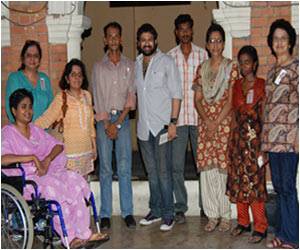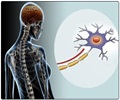The theme of World Multiple Sclerosis Day 2011, ‘Work and MS’ seeks to highlight the challenges faced by MS victims at the workplace and raise MS awareness among employers and the general public.

The theme of World MS Day 2011, ‘Work and MS’ seeks to highlight the obstacles and challenges faced by victims of MS at the workplace and hopes to provide a platform whereby organizations can work towards improving the work environment. When employers are aware of the disease, they are in a good position to understand the needs of victims of multiple sclerosis and can work towards reducing their discomfort at the workplace and help improve their productivity. Even though many MS patients can continue with their regular employment, employer assistance can go a long way in smoothening impediments in their work life.
Understanding causes, symptoms and treatment of multiple sclerosis
Multiple Sclerosis is a disease leading to degeneration of the nerves of the central nervous system. This condition occurs when the protective sheath, called Myelin, surrounding nerve fibers of the central nervous system gets damaged. Damage of myelin causes problems in the communication between the brain and other parts of the body.
When the damage caused to the nerves increases, functions controlled by the nervous system such as vision, writing, speech, memory, and walking take a beating. There appears to be a progressive pattern to the disease in some of its victims, while in others, MS is characterized by periods of remission.
Experts are still unable to nail the condition to a single cause, though most research points to the connection between disorders of the immune system and multiple sclerosis. The likely age of diagnosis of the disease is between 20 and 50 years. The disease can also strike children and the elderly.
Types of Multiple Sclerosis
When a victim suffers an attack of MS, there is an unexpected decline in physical abilities ranging from mild to severe, which could last for more than a few weeks.
Relapsing-remitting (RR) MS happens to be the most common type of multiple sclerosis affecting nearly 65%-80% of individuals. In this condition, victims suffer a number of attacks after which the symptoms may partially or completely disappear till the next attack or relapse. Some victims relapse in weeks while for some it may strike after a few years.
Nearly 10 to 20% of victims suffer Primary-progressive (PP) MS, where there is a gradual and progressive deterioration in physical abilities.
Mild cases of multiple sclerosis escape diagnosis for many years while in rare cases called as malignant or fulminant multiple sclerosis, victims experience rapid progression of multiple sclerosis symptoms.
Symptoms of Multiple Sclerosis
Multiple sclerosis may initially show up as a single symptom or many symptoms ranging from mild to severe. Nearly 70% of individuals with multiple sclerosis experience complete or partial remission from symptoms.
Most victims report visual disturbances like blurring of vision and pain as one of the first symptoms of multiple sclerosis. Other common symptoms are numbness, loss of sensation, fatigue, depression, unexplained fears, dizziness, tremors, problems with body balance, and trouble with coordination. Many victims are unable to concentrate on their tasks and may also portray loss of memory to a certain extent. Some victims are unable to control a sudden urge to laugh or weep.
As the disease progresses, bowel and bladder control can be a huge challenge to victims.
Diagnosis of MS
Due to the many symptoms portrayed by multiple sclerosis, the disease can go undiagnosed for months or years following the start of symptoms. Diagnosis is made after detailed physical and neurological examinations by neurologists.
Neurologists subject victims to MRI (magnetic resonance imaging) scans to help them evaluate changes in the brain.
Further, neurologists examine the cerebro-spinal fluid surrounding the brain and spinal cord, which helps spot the presence of abnormal chemicals or cells that point to the presence of multiple sclerosis.
Electro-physiological tests also help neurologists study the speed of impulses traveling through the nerves, which is important in diagnosis of MS.
Treatment of Multiple Sclerosis
In the absence of an absolute cure for multiple sclerosis, treatment essentially centers around four important areas- helping victims bounce back faster from attacks, reducing the number of attacks, retarding the progression of the disease and minimizing the complications of the disease.
The treatment ideally begins at the time of the first multiple sclerosis attack. Medications are prescribed to manage the symptoms.
Several studies have highlighted the importance of commencing treatment early for better outcomes. The role of support groups and counseling cannot be overemphasized, as this is a significant step in helping victims and caregivers cope with rigors of the disease. Regular communication between the patient and physician is imperative in monitoring the demands of the treatment.
Employment and Work life for Victims of MS
A recent insight conducted in Australia has been an eye-opener of sorts regarding the magnitude of challenge victims of MS face in their professional lives.
The first startling revelation showed that most Australians are unaware about the physical and psychological impact of the condition, hence are oblivious to the daily challenges of victims. This ignorance about the condition led 91% of Australians to believe that MS victims cannot continue in regular jobs and hence need to lead unproductive lives.
Misinformation about the condition has led many victims to suffer huge financial problems as many approach the disease with a lot of negativity. This attitude coupled with lack of employer support or discriminatory approach at the workplace for MS victims, can render otherwise able employees jobless, exacerbating allied psychological and physical problems. Undoubtedly, this is a huge drain on the economy with healthcare costs and diminished productivity at the workplace.
Statistics have also pointed out that nearly 85% of MS victims suffer the relapsing-remitting MS. In this condition, they suffer relapses or attacks marked by a decline in neurological function. These relapses are present for a certain period of time and it is at this time that employers can provide them with adequate support and empathy to help them recover.
Employers can weave their organizational policies around educating managers and team members to make the environment friendly towards MS victims. Knowing that the victim cannot be as productive during the relapse phase, perhaps help with options of telecommuting can help MS employees retain their jobs and bounce back during remission.
Adopting a non-discriminatory approach and providing equal opportunity is the least organizations can do in bringing immense hope to victims of MS battling a debilitating condition.
Here are some priceless contributions that employers can make to better the lives of Multiple sclerosis patients.
- Making offices and restrooms wheelchair friendly
- Designs of doors and faucets to cater to MS victims
- Enabling some time-off during the treatment phase
- Providing employees with telecommute option during the relapse phase
Source-Medindia













